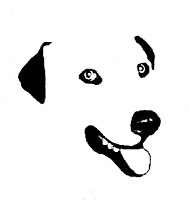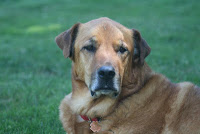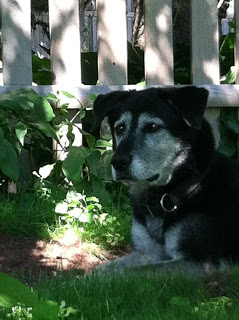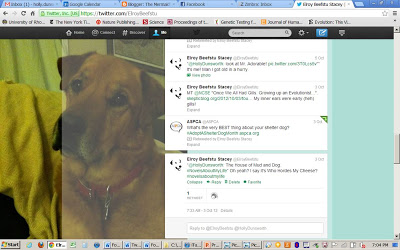

| Visitors Now: | |
| Total Visits: | |
| Total Stories: |

| Story Views | |
| Now: | |
| Last Hour: | |
| Last 24 Hours: | |
| Total: | |
FOR DOGKIND: Didactic, allegorical, disgusting, and adorable children’s book
Just a momentary interruption of our regularly scheduled MT programming …
My dog Elroy discovered the real origins of dogkind—our evolutionary tale of connectedness and change over deep time—and I recorded it. It’s written for dogs, but humans will find that it’s manageable from about eight years on up, and it speaks to kids of all ages. Elroy’s story engages humans, young and old, in scientific thinking. I’m posting Chapter 1 here in hopes of attracting a science buddy for Elroy. We’d love to share proceeds with our favorite education allies and non-profits* if they’ll help us get this book published and out to readers.
Figure 1.2. Connectin up dogs and prims to all the rest like the horned owl, guinea fowl, octopus, platypus, and human.
(ask HD for sources found by Google)
Figure 1.3. R.V. Endeavor: The ship that carried us home to end our three years of globetrottin. (
Figure 1.6. City tree trunk. Not a tree.
(http://www.water-waysirrig.com/)
If we had you at “evolution” or even if you’re just potentially interested in helping to get this book published then we hope you contact us at [email protected] so we can send you the whole manuscript for your consideration. In case you’d like to read some details from our proposal, here you go…
Categories: Children’s chapter book, fiction, science, nature, animals, pets, adventure, travel.
Project status: Complete manuscript. Illustrations needed.
Words: ~20,000 (11 chapters plus small appendix “A People’s History of Dogkind”)
Target age group: 8 years old and up
Style: Didactic and allegorical while disgusting and adorable.
One sentence summary: A wise and charming old dog tells the story of his life in which he discovers the real story of dog origins.
Between the lines: Evolution’s so obvious, anybody who’s curious and adventurous can see it.
Sources of inspiration: This is a dog’s mash-up of Darwin’s Origin of Species, Descent of Man, Expression of Emotions, Journal of Researches (Voyage of the Beagle), and, of course, his Autobiography.
Summary: As Elroy learns the ways of doghood he can’t help but wonder how it all began. When he kills a squirrel and loves it, and then when he lives with prims (wolves) and loves it, he’s transformed. He yearns to find out more about other dogs, other animals, and other ways of being around the world. So he and his pal Murphy embark on an expedition circling the globe, sending messages back home via carrier pigeon that reveal their hard-sought conception of a whole new perspective on doghood and its origins—the story that all dogs around the world tell their dogglings to this day! Upon their arrival home, initial reactions to the mutts’ discoveries are mixed. Most in the pack are fascinated and smell immediately how this new angle fits their, admittedly, limited perspective at the animal sanctuary where they’ve lived their whole lives, but other dogs are deeply offended by the notion that they could share common ancestors with those savage, beastly prims. After recounting the highlights of his life, which has been focused on hunting down life’s biggest questions, our curious mutt Elroy shares how his discovery connects dogs to prims to elephants and humans and even to squirrels, all the way back in time as one big family on earth, all working towards something larger than any one dog, and towards something more magnificent than anything anybody can conjure up behind the sniffer.
Format and illustrations: I’m open to ideas, but for now I’m thinking For Dogkind should be modeled after a 1940s-50s classic children’s hardback. The book needs to look epic, simple, and classic. I’d like the drawn illustrations (like Fig. 1.2) to share the spirit of the figure that I made for the title. A nice recent model for the look is Alexander McCall Smith’s The Great Cake Mystery. Ideally the book includes many small, simple line-drawings and one map. Plus three multi-page “notebooks” of sketches, brainstorms, and ideas with arrows, family trees, Venn diagrams, etc. They will be modeled after naturalist’s field notebook. (An alternative to drawings is to use photographs from free, open sources on the Internet. But I’m not sure how the printing costs of color photographs compares to hiring an artist for black and white drawings!)
Story behind the book: As a teacher and also as a member of a core team of educators with the Smithsonian’s Human Origins Program, I’m perpetually facing obstacles to learning and accepting evolution, to seeing humanity’s place in nature for what it is. After a particularly stimulating workshop with my Smithsonian team, it occurred to me how funny and downright ridiculous it would sound if a dog was disgusted to learn that he evolved from wolves, the way that humans are appalled by the notion they evolved from monkeys, fish, and primordial goo. I decided that my dogs, Elroy and Murphy, were the dogs to discover evolution and the ones to share their story, our story, with the rest of us. Thus, For Dogkind was born.
Relevancy, needs filled, problems solved, importance: People resist the notion that they’re part of the natural world. It’s certainly a problem, and not just in science education, but in how they make decisions and how they behave, overall, in the sociopolitical realm. Evolution—the fact that over many many generations all life on Earth shares common ancestors—is so controversial, still, that only half of American adults admit to accepting it. For Dogkind is a nice allegory for that obstacle—for the potentially dangerous paradigm of human exceptionalism—that we face as educators, neighbors, citizens, and animals in ecosystems. Additionally, For Dogkind is a tale of discovery—something that we want our children to emulate and to achieve, to sink their teeth into and never ever let go.
Author bio: HollyDunsworth is Assistant Professor of Anthropology at the University of Rhode Island where she teaches courses on human origins, evolution, and variation. At the early Miocene sites on Rusinga Island, Kenya she performs paleontological research where some of the most ancient fossil apes are preserved, and she also studies zoo apes. She’s a member of the Smithsonian Human Origins Program’s core education team, editor of the upcoming “Human Fossil Record” room for students at the on-line Nature Education Knowledge Project, and author of Human Origins 101. Her work is published in the Proceedings of the National Academy of Sciences, Journal of Human Evolution, PaleoAnthropology, Evolutionary Anthropology, Evolution: Education and Outreach, and other journals, as well as in Walking Upright, The Primate Fossil Record, Icons of Evolution, and 826 National’s Don’t Forget to Write for the Elementary Grades: 50 Enthralling and Effective Writing Lessons (Ages 5 to 12). She’s a regular contributor to the science blog The Mermaid’s Tale and one of her columns recently won the coveted 3 QuarksDaily 2012 “Charm Quark” science writing prize. Since it aired on NPR’s Weekend Edition, her totally sappy This I Believe essay “I Am Evolution” remains in the top five of the site’s most-read/heard columns of all time. You can read her cheeky advice to a boy with rhinotillexomania in New Scientist’s Why Don’t Penguins Feet Freeze? Her riff on asteroids made it onto McSweeney’s Internet Tendency! Holly grew up in Oviedo, Florida, and now lives in Peace Dale, Rhode Island with her husband and with her magnificent mutts, Murphy and Elroy.
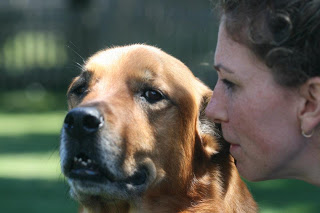 |
| When I’m not sharin my stories, Holly tells me hers. They’re not half bad. (credit: Julie Dunsworth) |
Here’s some of Holly’s evolution poetry that they say is for kids:
Elroy tweets (without pigeons) at @ElroyBeefstu
…we’re not against agents. Agents welcome! We’re just not going the traditional route by querying agents via email, one at a time, 4-8 weeks apart, with rarely even a receipt. We sort of get it: Who hasn’t written a kid’s book, right? Agents are busy. We know. But so are we. And we’re excited too. So this is a better strategy for us than depending entirely on some agent liking our cold query.
2012-10-24 04:21:01
Source: http://ecodevoevo.blogspot.com/2012/10/for-dogkind-didactic-allegorical.html
Source:



